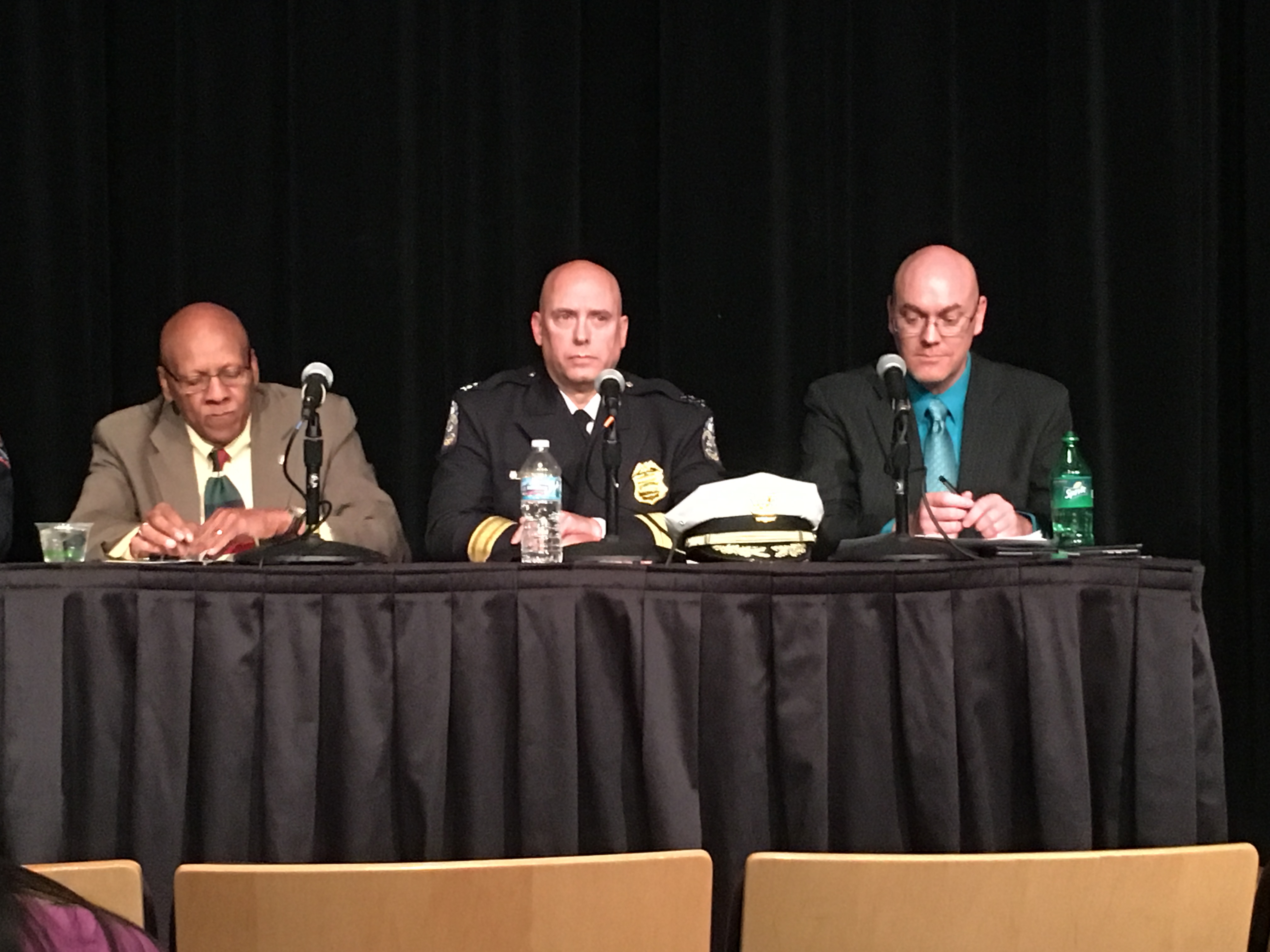
Left: City Councilman Mitchell Brown, Deputy Chief Thomas A. Quinlan of Columbus Police Department, and Ohio State Director of Emergency Management Bob Armstrong present on their specialized topics during the question and answer session at USG’s safety town hall. Credit: Caitlyn Sack | Lantern reporter
Six panelists from various safety departments around Ohio State and the city of Columbus joined forces to present information about student safety on Tuesday evening.
Sunder Sai, a second-year in neuroscience and deputy director of health and safety for Undergraduate Student Government, planned the town hall with the help of University Police.
“We really want this safety town hall forum to pose students’ safety concerns and questions,” Sai said.
Panelists included University Police Acting Chief Craig Stone; Director of Emergency Management Bob Armstrong; Deputy Chief of Columbus Division of Police Thomas Quinlan; Columbus City Councilman Mitchell Brown; and Off-campus Living Representative Ezra Baker.
The student safety town hall began with Armstrong discussing students’ concerns as to why Buckeye Alerts and Public Safety notifications are not sent out sooner.
The Clery Act requires all colleges and universities that participate in federal funding to share information concerning crime on campus, as well as police efforts to improve safety on or around campus, according to the Clery Center’s website.
“Sometimes we’ll get questions like, ‘Why didn’t you send (the notification)?’ And by the act, we’re required to send it on campus property or immediately adjacent to campus property,” Armstrong said. “It’s kind of hard to decide, ‘Do we take it beyond that, to Summit or (North) Fourth (streets)?’ We’re trying to stick to the Clery Act and make sure we get that notification out to you. It’s not an emergency notification.”
The Buckeye Alerts, which are primarily text messages or posts on social media, are sent out in urgent emergency situations. Armstrong reiterated the purpose of the Buckeye Alerts is for students to take immediate action in order to stay safe.
City Councilman Brown then discussed lighting issues in off-campus locations. He and his representatives urged students to take advantage of city representatives and report light outages via the 311 initiative, which is a way for Columbus citizens to submit service requests to the Columbus Service Center.
Though it is expensive and costs the city money, it’s what the city council is elected to do, he explained.
“If you see something, say something. Don’t just assume someone will take care of the issue,” Brown said.
Quinlan and Stone tackled questions concerning the joint jurisdiction, explaining that the team of University and Columbus police work together to be the eyes and ears of all areas.
Sai said he also wanted to address students’ concern about prolonged wait times for the Student Safety Service Safe Ride program.
Program coordinator Sean Bolender emphasized that though it wants to be able to meet every student need, the program is not a taxi service.
“I am saying we are not a taxi cab service because there is some confusion,” he said. “The safe-ride program works by trying to get the most number of rides in a year because each time we provide a ride, that’s a possible crime that we prevented by having you in our vehicle with two student officers.”
Bolender said the program is currently in the feasibility stage of an application that might increase technological abilities of the safe-ride program.
Stone also encouraged students to engage in the Bug Your Bike program, which involves registering bikes with the city of Columbus as property, to decrease bike theft on and around campus.
Stacey Renker, assistant director of Risk and Emergency Management, said she was pleased with how the town hall went.
“The interaction we saw at this event was wonderful, and the amount of students who showed up really showed an interest in the community,” she said.


